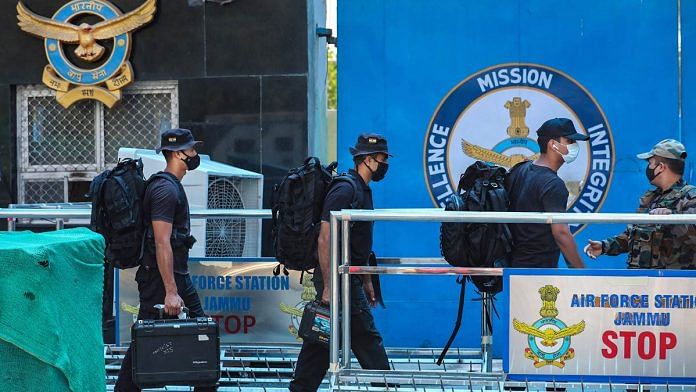New Delhi: Heralding new terror challenges for India, a drone was used to attack the Air Force station in Jammu early Sunday, with two improvised explosive device (IEDs) exploding “close to the helicopter hangar”, ThePrint has learnt.
While the explosions did not cause damage to any equipment, two IAF personnel sustained “very minor” injuries. Incidentally, the air force station in Jammu is also one of the bases for India’s military drones.
While one of the explosive devices fell on an administrative building close to the helicopter hangar, causing a hole in the roof, the other fell in an open area.
The Indian Air Force (IAF), in a Twitter post, said two “low intensity explosions” were reported. “One caused minor damage to the roof of a building while the other exploded in an open area,” it said.
It added that “there was no damage to any equipment. Investigation is in process along with civil agencies”. The IAF did not mention the drones but did point out that the roof was damaged.
Two low intensity explosions were reported early Sunday morning in the technical area of Jammu Air Force Station. One caused minor damage to the roof of a building while the other exploded in an open area.
— Indian Air Force (@IAF_MCC) June 27, 2021
There is still no clarity if one or two drones were used. Their origin is also not clear but sources said the drone or drones are likely to have been operated from within the Jammu region and close to the Air Force station.
The National Investigation Agency (NIA) is now likely to take over the probe into the terror attack, which comes amid a ceasefire at the Line of Control (LoC).
An NIA team Sunday visited the Air Force station along with members from multiple security agencies, police, bomb disposal squads and forensics.
Western Air Command chief Air Marshal Vivek Ram Chaudhari, along with Senior Air Staff Officer (SASO) Air Marshal Vikram Singh, also travelled to Jammu to take stock of the situation.
Defence Minister Rajnath Singh, who is on a three-day visit to Ladakh, spoke to IAF Vice Chief Air Marshal H.S. Arora in the morning about the attack that took place at about 1.30 am on Sunday.
Following the attack, multiple military stations were put on high alert.
According to initial inputs, an IAF patrolling team witnessed something dropping from the sky. An explosion immediately followed as the personnel rushed to the area. A second IED was dropped minutes later, which led to “very minor” injuries to two personnel, the sources said.
It was immediately not clear if the drones had dropped off the explosive or whether they were carrying them and landed at the spot with predesignated GPS settings and exploded on impact.
Sources said the issue is under probe and clarity is expected only later.
Jammu and Kashmir Police chief Dilbag Singh told reporters that the incident is being considered as a terror attack.
Sources in the security establishment see the attack as a security breach since the drone managed to fly into the high security area without being detected, and managed to carry out the attack.
Also read: Sea trials of first indigenous aircraft carrier INS Vikrant in July, commissioning mid-2022
Mi-17 helicopters could have been the target
Sources said both the explosions were of low intensity. The explosives, however, were dropped close to the aircraft hangars leading to the suspicion that IAF assets were the target.
“Had the IEDs fallen in the helicopter hangar, it would have caused damage. Thankfully, it fell a little away from it,” a source said.
While no fighters are based at the Jammu technical airport, it has assets like Mi-17 helicopters and transport aircraft.
The hangars are developed in such a way that they remain far away from the perimeter wall so that the assets are not damaged in case someone throws a stone or a grenade. Also, there are multiple layers of security one would have to break if an attack is launched on the ground to reach the hangars.
First drone attack
This is the first incident of a drone-based attack in the country, a situation long feared by the defence and security establishment.
Today’s incident was a minor one, but shows the modern day capabilities of launching attacks, a source said.
Way back in 2016, the sources said, internal deliberations had started to talk about possible vehicle-based IEDs and it came true in 2019 with the Pulwama attack.
In 2018, as the Pakistani Army started deploying a number of small drones along the Line of Control (LoC), fears were expressed in the establishment about the possibility of drones being used to carry out attacks.
While Pakistan has been using drones for supply of arms and ammunition to terror networks in Punjab and Jammu & Kashmir, this is the first time the system has been used to carry out an attack.
The forces are still in the process of acquiring anti-drone technology in large numbers. The Navy had recently gone in for procurement of Israeli anti-drone system “Smash 2000 Plus”.
The Defence Research and Development Organisation has also developed an anti-drone system that was deployed at the Red Fort for the Independence Day address by Prime Minister Narendra Modi.
(Edited by Arun Prashanth)
Also read: Army seeks infantry combat vehicles: What are they & why it’s taken 3 attempts to acquire them



